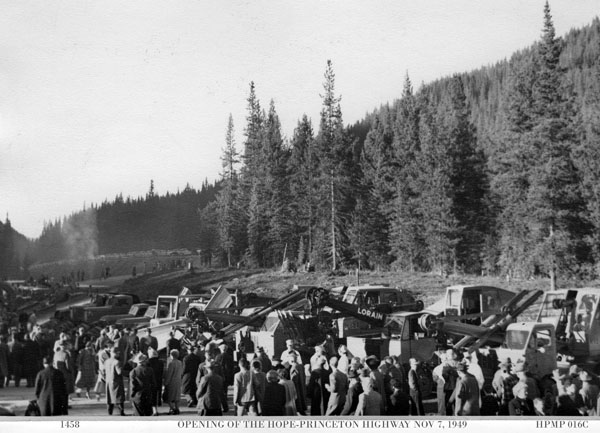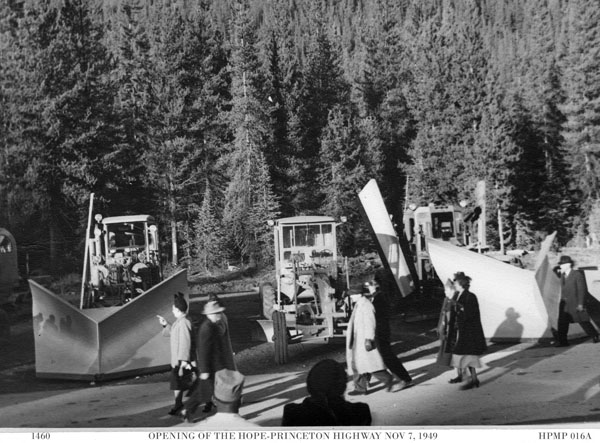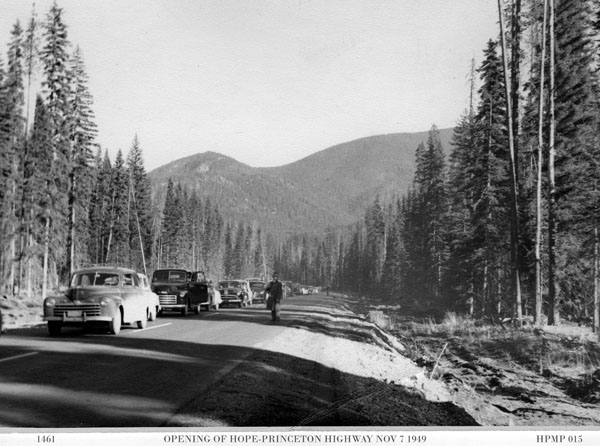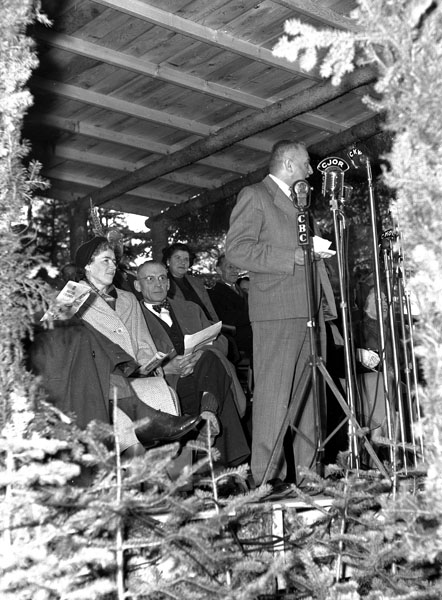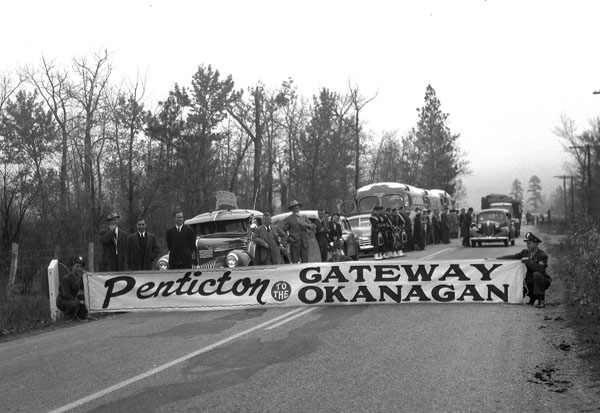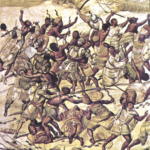THE QUEST TO COMPLETE THE HOPE – PRINCETON HIGHWAY
Historians say the Hope-Princeton Highway took 103 years to complete. Was it really started in 1846? The answer is yes.
The names are in our earliest recorded history of European visitors. Gold and furs were the driving force into the interior and it was the Hudson’s Bay Company that first requested an expedition. Alexander Anderson and 5 others followed Native trails and were the first to see the Okanagan. John Fall Allison was asked by Governor Douglas to find an easier route from Hope inland in 1858. His Brother-in-law, Edgar Dewdney followed his trail to Tulameen in 1861, using Royal Eng
ineer Sappers to build a narrow road.
The road always came up with subsequent governments, but it just couldn’t be finished. The road went as far as Sunshine Valley from Hope and up to Copper Creek from Princeton. Wars and Depressions came and went and still no through road.
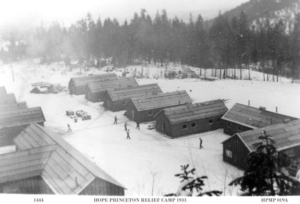 At the height of the depression, the Federal Government provided funds for construction of the road and the Province put into effect a work relief program. 40 relief camps were set along the route and workers came from all over Canada. These men worked year round in camp shacks where snow drifted in and hygiene was rare. But they did get fed regularly and could send money home to their families. Some never
At the height of the depression, the Federal Government provided funds for construction of the road and the Province put into effect a work relief program. 40 relief camps were set along the route and workers came from all over Canada. These men worked year round in camp shacks where snow drifted in and hygiene was rare. But they did get fed regularly and could send money home to their families. Some never
left the area and made their homes in Princeton working for the mines.
In 1937, the Interior Board of Trade, with delegates from every walk of life, walked from Princeton to Hope with much fan-fare. Accompanied by press corps and Politicians, they protested the inaction of both Victoria and Ottawa in completing the road. Then War was declared. There was a terrible injustice in 1941, that ended up helping the construction of the highway – The internment of Japanese Canadians.
An internment camp was set up at each end of the highway, one near Hope, the other n
ear Princeton. Now there was no shortage of cheap labour during the war years.
In 1943, another group calling themselves the “Caravan of Hope” gathered at Princeton. Around a hundred souls left early on Labour Day for the backwoods of Cambie Flats and on to Allison Lake. The road ended there and the trek to Skagit Bluffs was a good 10 miles off. Cars met them at the bluffs where workers were attempting to blast and scale the cliffs for a roadway. They arrived in Hope before 4pm.
The War was coming to an end when the B.C. Government made the ultimate commitment to the completion of Highway #3. In 1945, the construction contract was let to J. Tomlinson and E. Anderson. Work began in earnest that year and four years later, at a cost of $12,000,000, the route was completed.
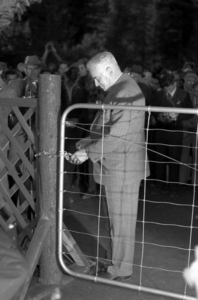
The cost was nearly $90,000 per mile from Hope to Kaleden, a total of 134 miles.
An opening ceremony was held November 2nd, 1949; with Premier Byron Johnson opening the gate at Allison Pass. Officiating were E.C. Carson, Minister of Public Works, and Herbert Anscomb, Minister of Finance.
Over 1000 bystanders waited many hours in the frosty weather to be the first to drive over the twisting road. Delegations from all principal communities rushed to speak with Politicians in the hope that Tourism money could be forthcoming with the rush of visitors to their towns and villages.
Just 5 hours after the ceremony, a car went off the road on the hill near
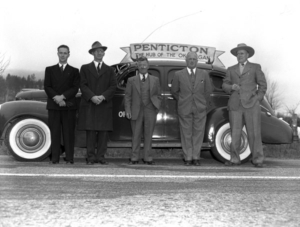
Sunshine Valley and 5 people were critically injured and 3 died of their injuries. They were the first in a long line of those who lost their lives on the winding road. I recall the Kettle Valley
Railway never lost a passenger in 50 years of operation.
Over 300 visitors arrived in Penticton that night and there was nowhere to stay. They say it was the start of something good.
RELATED ARTICLE – THE HOPE-PRINCETON GALLOWS
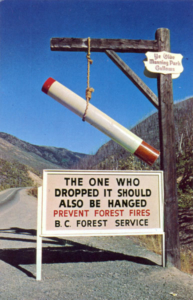 There is confusion about the history of this sign. Here’s the true story.
There is confusion about the history of this sign. Here’s the true story.
The “Big Burn” was first reported on August 8th, 1945 by a Canadian Pacific Airline pilot who saw it from his flight path. The smoke was so heavy that a Kamloops Forestry lookout spotted it at about the same time as a U.S. Forest Service tower in the Cascades called it in.
The story of the cigarette is not altogether true. Actually, the true cause of the fire was a slash burn that got away from workers building the Hope-Princeton Highway. Because of the rough terrain between the Allison hill and the Skagit Bluffs, it was not until August 11th that 140 men were able to reach the centre of the fire zone.The Forest Service took advantage of the Japanese camp at Tashme and pressed the internees to work the fire. That brought the force to well over 200 men. The fire was attacked for 11 days before bringing it under some kind of control. It wasn’t until August 26th during a long rain storm that it was declared “out”. By then the fire had devastated 5,920 acres of prime timber. The scar remained for many years.
The gallows wasn’t erected until well after the Hope-Princeton was officially opened in 1949. Funny thing about the sign is that it was at the start of the B.C. Forest Service forest fire prevention program. The U.S. had launched it’s Smokey Bear program at this time and the Bear quickly became a household symbol.
Canadians couldn’t make up their mind as to a symbol…who wanted Benny the Beaver preventing forest fires? So the gallows went up to the horror of some who travelled the road. The cigarette was the symbol of devastation even though the ravaged area was not caused by the butt. It wasn’t until 1956 that the Canadian Forestry Association bought rights to Smokey. We’ve shared it ever since.
When capital punishment ended in Canada in 1962, the gallows became inappropriate and was taken down.

